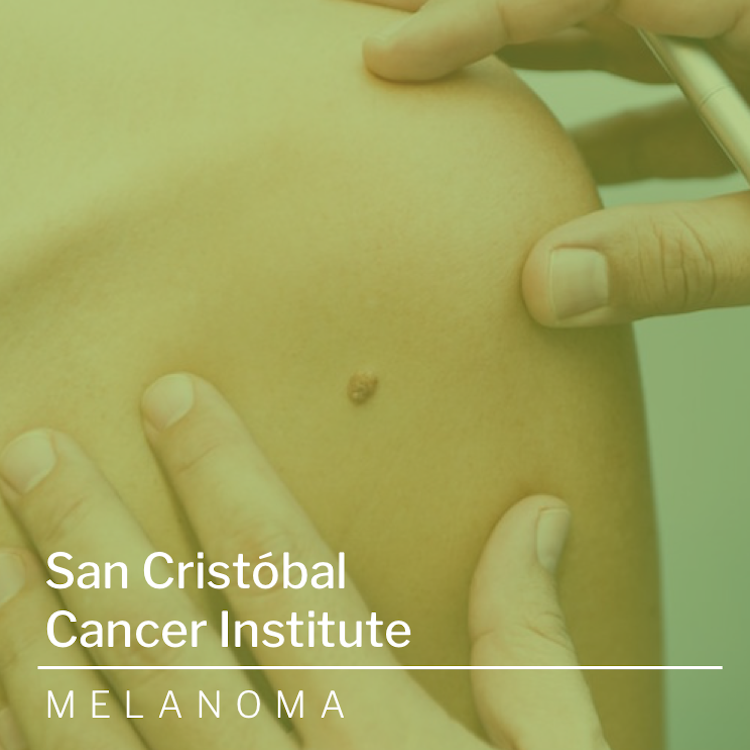
Melanoma Facts

Melanoma, the most serious type of skin cancer, develops in the cells that produce melanin to the skin. Melanoma can also form in your eyes and, rarely, in internal organs, such as your intestines.
The exact cause of all melanomas isn’t clear, but exposure to ultraviolet (UV) radiation from sunlight or tanning lamps and beds increases your risk of developing melanoma. Limiting your exposure to UV radiation can help reduce your risk of melanoma.
The risk of melanoma seems to be increasing in people under 40, especially women. Knowing the warning signs of skin cancer can help ensure that cancerous changes are detected and treated before the cancer has spread. Melanoma can be treated successfully if it is detected early.
Overview
Melanoma is a cancer that forms in melanocytes, the skin cells that produce a brown pigment known as melanin. These are the cells that darken when exposed to the sun, a protective response to shield the deeper layers of the skin from the harmful effects of UV rays. But, unlike other forms of skin cancer, melanoma may develop in parts of the body not normally exposed to sunlight, such as the groin or bottoms of the feet. It may also form in the eye.
Types
The most common melanomas are cutaneous, which develop on the skin, particularly in areas exposed to the sun. In men, the most common sites for melanoma are the chest or back. In women, the legs are affected most frequently. However, melanomas are also commonly found on the neck or face. Melanoma may also be found on parts of the body not usually exposed to the sun. Types of melanomas include:
- Superficial spreading melanoma: Superficial spreading melanoma is the most common type of melanoma. This form of the disease may grow for several years along the outer layer of the skin. Superficial spreading melanomas may be elevated and have irregular borders. They may be brown with black or pink edges. Seventy percent of cases diagnosed are superficial spreading melanomas, according to the National Cancer Institute (NCI).
- Nodular melanoma: After first appearing on the surface of the skin, nodular melanoma may quickly grow into deeper layers of the skin. This form of the disease may appear as a bump or growth. Nodular melanomas account for 15 percent of all cases.
- Acral-lentiginous melanoma: Acral-lentiginous melanoma is most common among people with darker skin. This type of melanoma represents up to 70 percent of melanomas in African Americans and 46 percent of all cases in Asians, according to the NCI. Acral-lentiginous melanoma may be found the palms of the hands, soles of the feet and under the nails.
- Lentigo maligna melanoma: Lentigo maligna melanomas are most often found in adults on the arms, legs, face, neck and other areas exposed to the sun. The risk of this type of melanoma may increase with age because of prolonged sun exposure. Lentigo maligna is the most common form of melanoma in Hawaii, according to the Skin Cancer Foundation.
- Amelanotic and desmoplastic melanomas: These two similar and rare forms of melanoma may be aggressive and difficult to diagnose. Amelanotic melanoma may be difficult to spot because of its lack of pigment. Desmoplastic melanoma may be found on the head and neck of elderly patients.
- Ocular melanoma: Ocular melanoma develops in the melanocytes that give eyes their color. They account for about 3 percent of all melanoma cases, according to the Ocular Melanoma Foundation. More than 2,000 cases of ocular melanoma are diagnosed each year.
Symptoms
Melanomas can develop anywhere on your body. They most often develop in areas that have had exposure to the sun, such as your back, legs, arms and face. Melanomas can also occur in areas that don’t receive much sun exposure, such as the soles of your feet, palms of your hands and fingernail beds. These hidden melanomas are more common in people with darker skin.
The first melanoma signs and symptoms often are:
- A change in an existing mole
- The development of a new pigmented or unusual-looking growth on your skin
Melanoma doesn’t always begin as a mole. It can also occur on otherwise normal-appearing skin.
- Normal moles: Normal moles are generally a uniform color — such as tan, brown or black — with a distinct border separating the mole from your surrounding skin. They’re oval or round and usually smaller than 1/4 inch (about 6 millimeters) in diameter — the size of a pencil eraser. Most people have between 10 and 45 moles. Many of these develop by age 50, although moles may change in appearance over time — some may even disappear with age.
- Unusual moles that may indicate melanoma: To help you identify characteristics of unusual moles that may indicate melanomas or other skin cancers, think of the letters ABCDE:
- A is for asymmetrical shape. Look for moles with irregular shapes, such as two very different-looking halves.
- B is for irregular border. Look for moles with irregular, notched or scalloped borders — characteristics of melanomas.
- C is for changes in color. Look for growths that have many colors or an uneven distribution of color.
- D is for diameter. Look for new growth in a mole larger than 1/4 inch (about 6 millimeters).
- E is for evolving. Look for changes over time, such as a mole that grows in size or that changes color or shape. Moles may also evolve to develop new signs and symptoms, such as new itchiness or bleeding.
Cancerous (malignant) moles vary greatly in appearance. Some may show all of the changes listed above, while others may have only one or two unusual characteristics.
Hidden melanomas: Melanomas can also develop in areas of your body that have little or no exposure to the sun, such as the spaces between your toes and on your palms, soles, scalp or genitals. These are sometimes referred to as hidden melanomas because they occur in places most people wouldn’t think to check. When melanoma occurs in people with darker skin, it’s more likely to occur in a hidden area.
- Melanoma under a nail. Acral-lentiginous melanoma is a rare form of melanoma that can occur under a fingernail or toenail. It can also be found on the palms of the hands or the soles of the feet. It’s more common in blacks and in other people with darker skin pigment.
- Melanoma in the mouth, digestive tract, urinary tract or vagina. Mucosal melanoma develops in the mucous membrane that lines the nose, mouth, esophagus, anus, urinary tract and vagina. Mucosal melanomas are especially difficult to detect because they can easily be mistaken for other far more common conditions.
- Melanoma in the eye. Eye melanoma, also called ocular melanoma, most often occurs in the uvea — the layer beneath the white of the eye (sclera). An eye melanoma may cause vision changes and may be diagnosed during an eye exam.
Diagnosis
Sometimes cancer can be detected simply by looking at your skin, but the only way to accurately diagnose melanoma is with a biopsy. In this procedure, all or part of the suspicious mole or growth is removed, and a pathologist analyzes the sample. Biopsy procedures used to diagnose melanoma include:
- Punch biopsy. During a punch biopsy, your doctor uses a tool with a circular blade. The blade is pressed into the skin around a suspicious mole, and a round piece of skin is removed.
- Excisional biopsy. In this procedure, the entire mole or growth is removed along with a small border of normal-appearing skin.
- Incisional biopsy. With an incisional biopsy, only the most irregular part of a mole or growth is taken for laboratory analysis.
The type of skin biopsy procedure you undergo will depend on your situation. Doctors prefer to use punch biopsy or excisional biopsy to remove the entire growth whenever possible. Incisional biopsy may be used when other techniques can’t easily be completed, such as if a suspicious mole is very large.
Stages
If you receive a diagnosis of melanoma, the next step is to determine the extent (stage) of the cancer. To assign a stage to your melanoma, your doctor will:
- Determine the thickness. The thickness of a melanoma is determined by carefully examining the melanoma under a microscope and measuring it with a special tool (micrometer). The thickness of a melanoma helps doctors decide on a treatment plan. In general, the thicker the tumor, the more serious the disease.
- See if the melanoma has spread. To determine whether your melanoma has spread to nearby lymph nodes, your surgeon may recommend a procedure known as a sentinel node biopsy. During a sentinel node biopsy, a dye is injected in the area where your melanoma was removed. The dye flows to the nearby lymph nodes. The first lymph nodes to take up the dye are removed and tested for cancer cells. If these first lymph nodes (sentinel lymph nodes) are cancer-free, there’s a good chance that the melanoma has not spread beyond the area where it was first discovered.
Cancer can still recur or spread, even if the sentinel lymph nodes are free of cancer. Other factors may go into determining the aggressiveness of a melanoma, including whether the skin over the area has formed an open sore and how many dividing cancer cells are found when looking under a microscope.
Melanoma is staged using the Roman numerals I through IV. A stage I melanoma is small and has a very successful treatment rate. But the higher the numeral, the lower the chances of a full recovery. By stage IV, the cancer has spread beyond your skin to other organs, such as your lungs or liver.
Treatment
The best treatment for you depends on the size and stage of cancer, your overall health, and your personal preferences.
Treating early-stage melanomas: Treatment for early-stage melanomas usually includes surgery to remove the melanoma. A very thin melanoma may be removed entirely during the biopsy and require no further treatment. Otherwise, your surgeon will remove the cancer as well as a border of normal skin and a layer of tissue beneath the skin. For people with early-stage melanomas, this may be the only treatment needed.
Treating melanomas that have spread beyond the skin: If melanoma has spread beyond the skin, treatment options may include:
- Surgery: If melanoma has spread to nearby lymph nodes, your surgeon may remove the affected nodes. Additional treatments before or after surgery also may be recommended.
- Chemotherapy. Chemotherapy uses drugs to destroy cancer cells. Chemotherapy can be given intravenously, in pill form or both so that it travels throughout your body. Chemotherapy can also be given in a vein in your arm or leg in a procedure called isolated limb perfusion. During this procedure, blood in your arm or leg isn’t allowed to travel to other areas of your body for a short time so that the chemotherapy drugs travel directly to the area around the melanoma and don’t affect other parts of your body.
- Radiation therapy. This treatment uses high-powered energy beams, such as X-rays, to kill cancer cells. Radiation therapy may be recommended after surgery to remove the lymph nodes. It’s sometimes used to help relieve symptoms of melanoma that has spread to another area of the body.
- Biological therapy. Biological therapy boosts your immune system to help your body fight cancer. These treatments are made of substances produced by the body or similar substances produced in a laboratory. Side effects of these treatments are similar to those of the flu, including chills, fatigue, fever, headache and muscle aches. Biological therapies used to treat melanoma include interferon and interleukin-2, ipilimumab (Yervoy), nivolumab (Opdivo), and pembrolizumab (Keytruda).
- Targeted therapy. Targeted therapy uses medications designed to target specific vulnerabilities in cancer cells. Side effects of targeted therapies vary, but tend to include skin problems, fever, chills and dehydration. Vemurafenib (Zelboraf), dabrafenib (Tafinlar) and trametinib (Mekinist) are targeted therapy drugs used to treat advanced melanoma. These drugs are only effective if your cancer cells have a certain genetic mutation. Cells from your melanoma can be tested to see whether these medications may help you.
Resources
San Cristobal Cancer Institute offers a wide array of options to help our patients feel calm and supported during the process of screening, diagnosis and treatment, as well as getting back to life after cancer. Browse our alternatives for patients – including financial aid for those eligible – in our Patient Resources section.
If you’d like to learn more about Melanoma through our San Cristóbal Education Resources, attend our events or learn about our Cancer Center, please contact us.
Knowledge is Power.
Education is one of our strongest tools at San Cristóbal Cancer Institute, empowering patients and their families with complete and updated information about more than a dozen types of cancer and providing first-hand knowledge through our dedicated team of cancer experts. If you’d like to know more, please get in touch with us. We look forward to offering you and your family powerful cancer awareness and the most comprehensive care.
